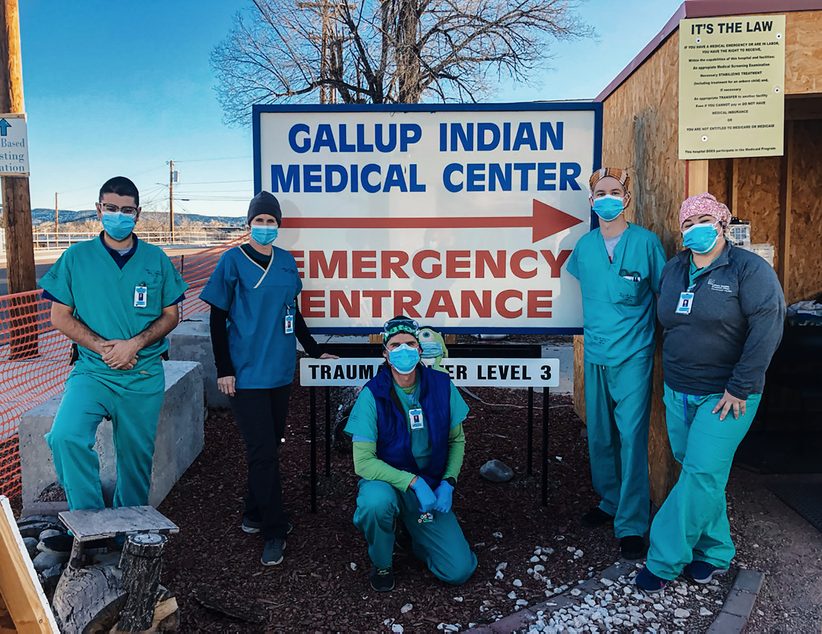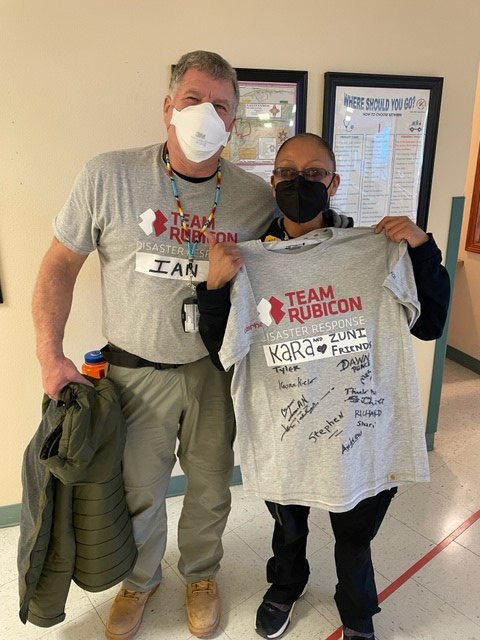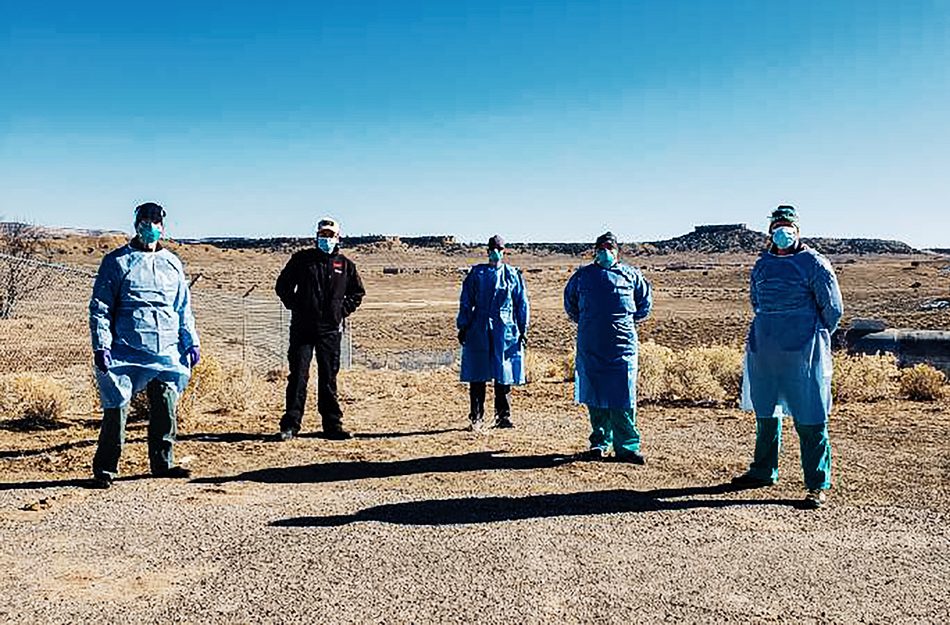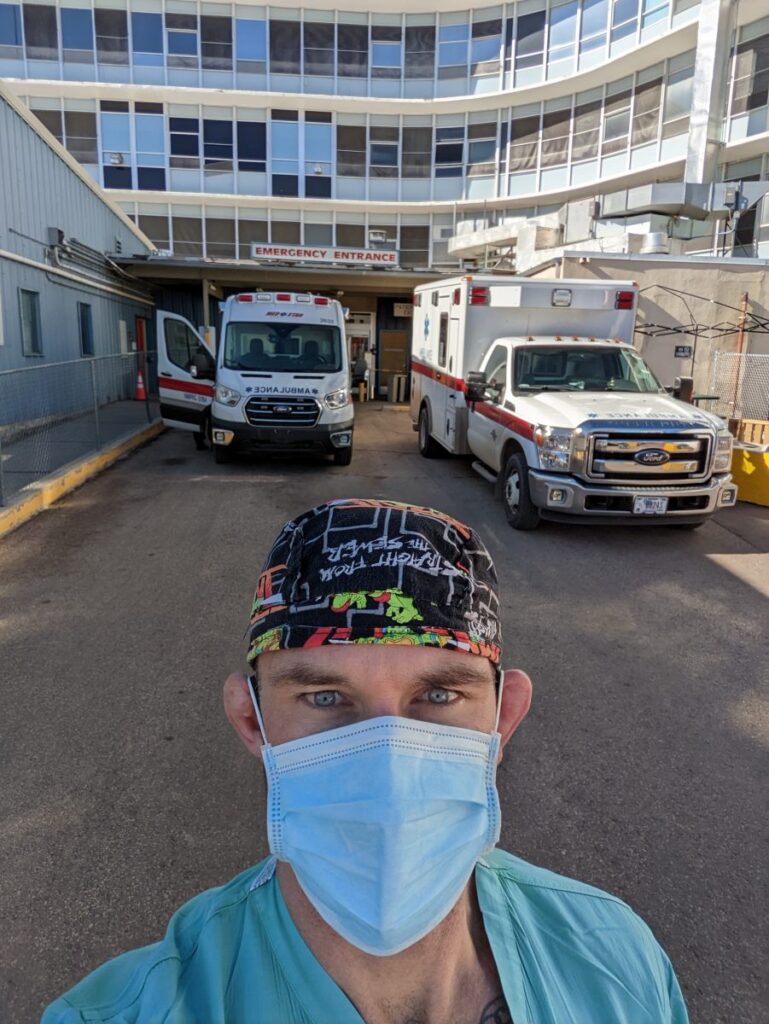From the beginning of the coronavirus pandemic in the United States, the Navajo people were among the hardest hit. At one point, the Navajo Nation had the highest per-capita rates of infection anywhere in the U.S. And, the pandemic has had a disproportionate impact here.

For Team Rubicon, it was a call to lean in. From April of 2020 through December of ’21 Team Rubicon deployed hundreds of Greyshirts to the Navajo Nation, where they served more than 5,000 patients and assisted in distributing more than 12,400 vaccines. Then, in early ’22, Greyshirts returned to deliver more than 1,500 vaccinations, administer nearly 4,000 COVID-19 tests, and to support the most recent COVID surge there.
Three Greyshirts who deployed to the Navajo Nation this year reflect on their time in service.
Out of the ER and into a Life-Changing Experience
My experience in Gallup working at Gallup Indian Medical Center with Team Rubicon was rich in all the ways that matter to me. I had a great team to work with and accommodations and food were fine. What made my experience there so wonderful were all the fabulous team members and the local people we got to meet and work with. The fact that the local natural landscapes were overwhelmingly beautiful made the oftentimes bitter-cold temperatures and prevailing winds at the 6,000-foot altitude all quite irrelevant.
Gallup is sometimes noted as having a high crime rate, but it’s also been named by Rand McNally as the most patriotic town in the U.S. It’s an interesting fact and supported by the presence of many, many, American flags I saw while there. The Navajo have a well-known, and deservedly proud history of military service, including with the Code Talkers of WWII. This also is remarkable when one considers these indigenous peoples’ very poor treatment, to say the least, in the not-too-distant history of the American West. It was refreshing and a heartwarming experience to feel and see the genuine welcoming nature of the local people.

A highlight for me and my team members was being invited by a medical assistant and member of the Zuni tribe—the Zuni Indian Reservation is roughly half an hour south of Gallup—to a local dance. Of course, my workmates and I were at first not sure about this as it started at around 10 p.m. But, after a little discussion, we realized it was a traditional Zuni spiritual dance that usually no outsiders would be welcome at or invited to. We felt honored.
We were informed by our colleague that she would have to get approval from tribal elders before we were allowed to go. The location of which is known only to the local community, and the site of the dance actually moves around throughout the late hours of the night. But within a few hours of the end of our workday at the hospital, we received the green light, and the four of us could not wait to go.
There were no cameras allowed and no talking. We were universally made to feel very welcome by all present. Even now, it’s very hard to put into words that night, but it was a full-on life-changing experience for me.
—Ian Tully
Multiple Deployments, Many New Friends
My impression of the Navajo, or Diné, people is that they are friendly, polite, and fiercely proud of their heritage—like Southerners and more especially, Texans. Being a Texan myself, I can recognize that.
It was not long into my stint at the Navajo Nation, providing COVID-19 surge medical support, that I noticed another charming similarity: the Navajos not only respect their elders, they revere them. Older people are addressed as “Grandpa” or “Grandma”, which is the same as “Mr. Tom” or “Ms. Sally” in the South. They have a matriarchal society, so elderly women are at the top. The Navajos cherish their heroes, especially the Code Talkers, so if you want to start a friendly conversation, just ask about them.
It appeared to me that most of the elderly people speak Navajo fluently, and for some, it’s still the primary or only language. Most young Navajos, however, were not fluent in their native language, though they all seem to know lots of words. I recall meeting just three or four at the hospital who are. One of the nurse aides I met told me Navajo was her first language, and that she only began to learn English in the first grade. Today, she can still read and write Navajo.
I also learned that the word for white people is bilagáana, and that it is neutral ordinarily, not a pejorative.
I deployed to the Navajo Nation multiple times with Team Rubicon, in December of 2020, January and March of ’21, and most recently this past January. I spent nearly 300 hours in the ER in Gallup, primarily serving as an ER tech—aka nurses aide—except when I worked in the Fast Track building and did some splinting and bandaging. I made friends there, both Navajo and non-Navajo, who recognized me and were evidently glad to see me again after nine months. And, it was interesting to learn about a different culture firsthand, though it seems there are many more similarities than differences with people I meet every day in East Texas. In the end, these things—these memories—make me happy and overcome all the devastation and loss seen during the pandemic and in the ER.
—Joe Allport

In Serve the Diné, Lessons Learned from New Peers
My first experience with Team Rubicon in 2020, serving on a team at the Navajo Nation in Chinle, AZ, for Operation Kick the King, Team Rubicon’s COVID-19 response.
As an emergency/trauma department registered nurse, I had been able to work across the country with several crisis response assignments during the pandemic. But, I was eager to be able to volunteer as well and honored to assist the Diné people during the disaster declaration.
In June of 2020, I spent two weeks working alongside Indian Health Services in Chinle. As an emergency/trauma department nurse I worked directly with IHS staff, local residents who were nurses, and techs who were all serving their own indigenous communities. I also got to witness, and appreciated, the work the local medicine men did in conjunction with the IHS, and the lessons they taught Team Rubicon members about their rituals and cultural practices, and about incorporating that with the care at the hospitals.

Then, in January of 2022, I once more had the opportunity to serve the Navajo people with Team Rubicon, this time in Gallup, NM. Gallup was very different from Chinle in many ways. For starters, Chinle is actually reservation land, and we were operating there early in the pandemic, before vaccinations were available, and during a pretty strict community lockdown. Gallup is a much bigger town. And, there was the huge volume of testing that Team Rubicon was helping with—both car-based and in the Emergency Department, as well as the large amount of staff who were out sick with COVID.
Meeting the diverse, capable, motivated professionals I got to team up with, and experiencing the heart and integrity of those working to serve their own community at their Indian Health Service hospital, are among the most rewarding aspects of getting to serve. Team Rubicon handled all the details of travel, logistics, and keeping us fed and housed and safe in order for us to be able to do our job, which was any and everything that may need to get done to help. As a nurse in the emergency department, that included everything from cleaning rooms and stocking supplies to performing chest compressions in a code to transporting patients to CT scans or to their rooms or off-site to the motel serving as the quarantine site for the community.
Returning to the hustle and stress and work at my “real life” hospitals after my deployments, it was good to be reminded of the reasons behind my work in the pandemic, the actual work with the patients, and being aware of each interacting member of a community. Being able to serve my country, and the Diné, in a time of great need was recharging, even though we worked hard in a stressful situation. It is important also to see and be part of a team working hard in an area that, in the best of times, is so resource-limited. I made several lasting contacts and connections with fellow Team Rubicon members and also locals.



